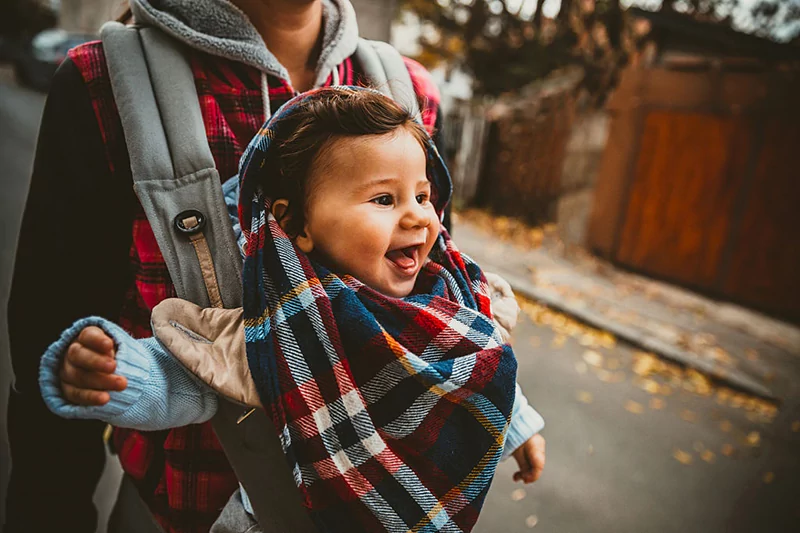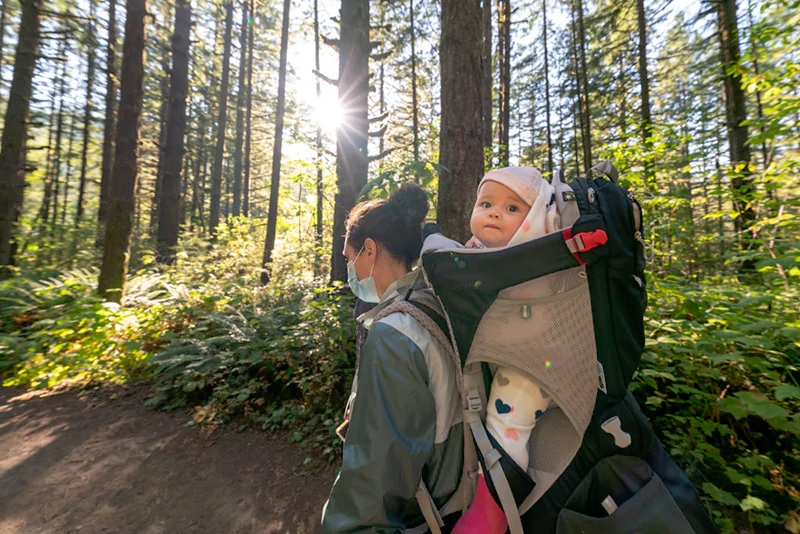There are many different carriers on the market to choose from, but most of them will not work accordingly. A carrier will work for you if it can securely hold your baby without any struggle and has straps that are adjustable to grow with your body. It’s always best to try on a carrier before buying it because they vary in size, material, style, and weight capacity.
A lot of people don’t think about their carrying method until after the baby is born, which makes finding an appropriate one more difficult.
Knowing that your instincts will be working with you when finding the suitable carrier, we’ve compiled a list of what to take into consideration before buying:
What is your postpartum body type?
Physical Fitness: You need to make sure you can carry your baby comfortably and easily for at least an hour without getting too exhausted. No one fits into a carrier the same way all the time, so try on several different types considering head strength, shoulders width, and torso size.
Health Concerns: If your doctor advises against it, it is not likely to work well for you or your baby. It’s always wise to consult both his professional opinion and your common sense.
What is your shape?
Are you petite or large framed? Do you have thin shoulders or long legs? A carrier that worked well for one of your friends may not work for you, so consider your build before purchasing.
Taller women tend to prefer more structured carriers with waist belts, while shorter women may not need one at all.
Read more: Best Baby Carrier For Petite Mom
What are the best positions for your baby?
Be sure to watch how your baby reacts when in different types of carriers before ruling them out entirely. For example, an older child may have a different opinion about being held close than a six-week-old infant.
How much money are you willing to spend?
Carriers can range from $20 to several hundred dollars or more. Smaller carriers that meet all of your criteria may be a better deal for your budget, while larger carriers may be a better fit for your body type.
Keep in mind that a well-made carrier should last at least through one baby and possibly even multiple children, if not the child’s whole childhood depending on your family size and budget.
What do you need in a carrier?
If this is your first baby and you know nothing about carriers, it might be best to purchase one with all the features possible. This way, if it lasts through several children, you won’t need to worry about buying another carrier.
Read more: COMMON BABYWEARING MYTHS
What do you want in a carrier?
A feature that might be wonderful for one parent might not matter at all to another, so try on several different carriers before making your final decision. If it is your first child and you know nothing about carriers, then this consideration will be less important.
Where do you plan to use the baby carrier?
Do you need a carrier that will fit in your diaper bag or purse? If so, make sure it has a smaller folded size. Do you live in an area with lots of mountains for walking on trails or up hills? Then a sling that can convert into a backpack might be for you.
What is your level of experience with baby carriers?
Be sure to factor in how much practice you need with a carrier before you start using it with your baby. It might take some time to put the carrier on and then get your baby into it without any fumbling or struggling, so don’t expect to master a carrier with a newborn in it in less than a week.
How much do you want to carry?
The amount you will be able to or allowed to carry your baby will vary greatly depending on the type of carrier you purchase. If you’re planning on using the carrier for hiking, then you will want to make sure it has a high weight limit of at least 40 pounds.
Where does your baby’s head need to go?
A newborn’s neck isn’t fully developed yet, and their heads will likely bobble around a lot if they are not held securely. Depending on the carrier you choose, your baby will either rest on top of your chest or in an upright position against it.
Does the material feel comfortable to you?
Most carriers are made from cotton, which is breathable and absorbent. However, some babies can be sensitive to this type of material, so do not judge the comfort level for your baby until after you’ve tried it on. When testing the carrier, make sure you will be able to fully buckle or zip it up before putting your little one inside so that they don’t wiggle out during the test run.
Are there any features that you need?
A hood can provide extra protection from sun or rain, and a pocket can be used for carrying small items like your keys or cell phone. If you want to breastfeed in the carrier, make sure it’s designed for this purpose.
Is there anyone else who is going to wear the carrier?
For example, if you plan on using the carrier with another child (maybe an older one), make sure it can be used as a multi-use carrier. If you plan to share the carrier with your partner, then look for an adjustable one that fits both of your body types.
Will you be wearing your baby often?
The best type of carrier for a parent who will regularly carry their baby is a soft carrier, which can be used right away with a newborn. If you plan to wear your baby often but only occasionally, then choose a carrier that is easy for you to put on and take off quickly without assistance.
Are you willing to put in the effort to learn how to use the baby carrier?
Take a moment to assess your previous experience with carriers and whether or not you have models that tend to be comfortable for both you and your baby. Also, consider if this will be a short-term investment or a long-term one by looking at how easy it might be to use with an older baby. If you’re committed, then don’t let the learning curve scare you off!
Will you be going on long walks or hikes?
A carrier that is meant for hiking will provide your baby with extra back and hip support. In addition, the carrier should have a waist belt to transfer some of the weight to your hips instead of your back.
Are you planning to go on long flights?
Pack a soft carrier when traveling by plane to avoid the heavy bulk of a piece of luggage, especially if you are asked to gate-check it. For added convenience, pack items like baby’s change of clothes in an easily accessible pocket so that you do not have to unpack the entire carrier just to reach them.
Will you be traveling by car and need a seat belt tether?
If your baby is going to sit in their seat instead of on your lap while riding in a car, then look for a carrier with a seat belt strap that can be attached between the legs to keep them safe during travel.
Do you need to nurse easily?
Check if the carrier has a design that enables you to discreetly breastfeed or bottle-feed your baby without having to remove them from the carrier. Also, look for easy access openings at the top of the panel so that you can quickly unzip it to access your baby.
Is the carrier designed with safety in mind?
The shoulder straps should have more padding than the waist belt so that it does not dig into your skin while wearing them. It’s also important to consider how adjustable the carrier is by assessing if the chest clip, waist belt, and leg openings are easy to adjust.
There are many factors that go into choosing the right carrier for you and your baby. Some carriers might work for your partner or older child but are not beneficial to you or your growing baby. Other carriers are great for dads to use with their babies but are cumbersome to learn how to put on by yourself during a diaper change. With some research, you will be able to find the right carrier that is both comfortable and functional.



